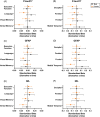Plasma phosphorylated tau-217 exhibits sex-specific prognostication of cognitive decline and brain atrophy in cognitively unimpaired adults
- PMID: 37639492
- PMCID: PMC10843677
- DOI: 10.1002/alz.13454
Plasma phosphorylated tau-217 exhibits sex-specific prognostication of cognitive decline and brain atrophy in cognitively unimpaired adults
Abstract
Introduction: Accumulating evidence indicates disproportionate tau burden and tau-related clinical progression in females. However, sex differences in plasma phosphorylated tau (p-tau)217 prediction of subclinical cognitive and brain changes are unknown.
Methods: We measured baseline plasma p-tau217, glial fibrillary acidic protein (GFAP), and neurofilament light (NfL) in 163 participants (85 cognitively unimpaired [CU], 78 mild cognitive impairment [MCI]). In CU, linear mixed effects models examined sex differences in plasma biomarker prediction of longitudinal domain-specific cognitive decline and brain atrophy. Cognitive models were repeated in MCI.
Results: In CU females, baseline plasma p-tau217 predicted verbal memory and medial temporal lobe trajectories such that trajectories significantly declined once p-tau217 concentrations surpassed 0.053 pg/ml, a threshold that corresponded to early levels of cortical amyloid aggregation in secondary amyloid positron emission tomography analyses. CU males exhibited similar rates of cognitive decline and brain atrophy, but these trajectories were not dependent on plasma p-tau217. Plasma GFAP and NfL exhibited similar female-specific prediction of medial temporal lobe atrophy in CU. Plasma p-tau217 exhibited comparable prediction of cognitive decline across sex in MCI.
Discussion: Plasma p-tau217 may capture earlier Alzheimer's disease (AD)-related cognitive and brain atrophy hallmarks in females compared to males, possibly reflective of increased susceptibility to AD pathophysiology.
Keywords: Alzheimer's disease; amyloid positron emission tomography; cognition; cognitively unimpaired; glial fibrillary acidic protein; medial temporal lobe; neurofilament light; phosphorylated tau217; plasma biomarkers; sex differences; verbal memory.
© 2023 The Authors. Alzheimer's & Dementia published by Wiley Periodicals LLC on behalf of Alzheimer's Association.
Conflict of interest statement
GTB and HCK are employees and stockholders of Janssen R&D (Johnson & Johnson). The remaining authors have nothing to disclose. Author disclosures are available in the supporting information.
Figures





References
Publication types
MeSH terms
Substances
Grants and funding
- U19 AG063911/AG/NIA NIH HHS/United States
- RF1 AG032289/AG/NIA NIH HHS/United States
- P30 AG062422/AG/NIA NIH HHS/United States
- RF1 AG068325/AG/NIA NIH HHS/United States
- P01 AG019724/AG/NIA NIH HHS/United States
- RF1 AG079176/AG/NIA NIH HHS/United States
- R01 AG072475/AG/NIA NIH HHS/United States
- U01 NS100608/NS/NINDS NIH HHS/United States
- R01 AG032289/AG/NIA NIH HHS/United States
- U54 NS092089/NS/NINDS NIH HHS/United States
- R01 AG045611/AG/NIA NIH HHS/United States
- K23 AG073514/AG/NIA NIH HHS/United States
- UF1 NS100608/NS/NINDS NIH HHS/United States
- AARF-23-1145318/ALZ/Alzheimer's Association/United States
- L30 AG069301/AG/NIA NIH HHS/United States
- K24 AG045333/AG/NIA NIH HHS/United States
- AARF-22-974065/ALZ/Alzheimer's Association/United States
- R01 AG048234/AG/NIA NIH HHS/United States
- R01 AG038791/AG/NIA NIH HHS/United States
LinkOut - more resources
Full Text Sources
Medical
Miscellaneous

